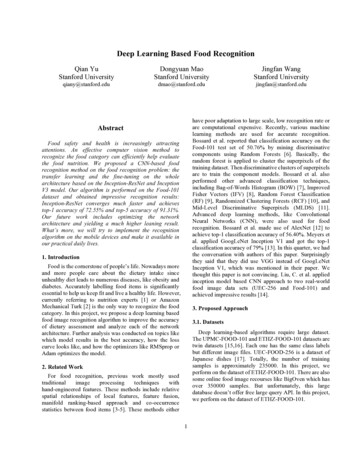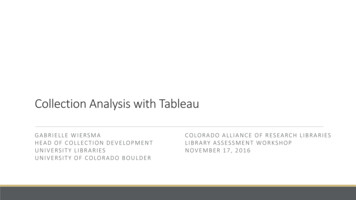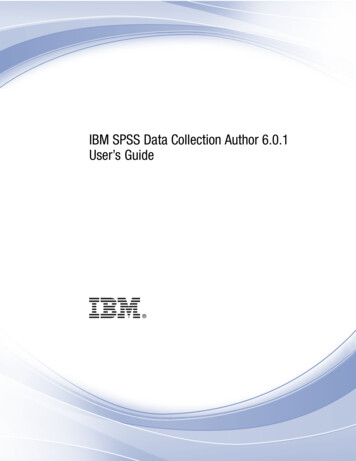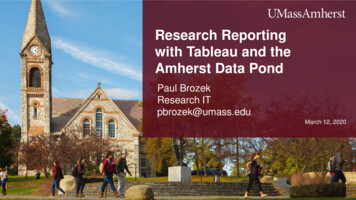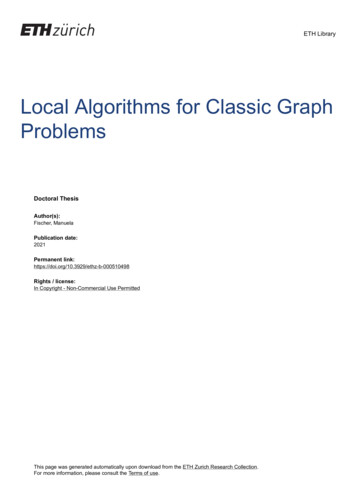
Transcription
ETH LibraryLocal Algorithms for Classic GraphProblemsDoctoral ThesisAuthor(s):Fischer, ManuelaPublication date:2021Permanent s / license:In Copyright - Non-Commercial Use PermittedThis page was generated automatically upon download from the ETH Zurich Research Collection.For more information, please consult the Terms of use.
DISS. ETH NO. 27521Local Algorithmsfor Classic Graph ProblemsA thesis submitted to attain the degree ofDOCTOR OF SCIENCES of ETH ZURICH(Dr. sc. ETH Zurich)presented byManuela FischerM.Sc. ETH in Computer Scienceborn on 14 February 1992citizen of Switzerlandaccepted on the recommendation ofProf. Dr. Mohsen Ghaffari, examinerProf. Dr. Fabian Kuhn, co-examinerProf. Dr. David Peleg, co-examinerProf. Dr. Seth Pettie, co-examiner2021
AcknowledgmentsI wish to express my deepest gratitude to my advisor Mohsen Ghaffari for the enormous trust and effort he put into me by allowing meto be his first Ph.D. student. He not only provided me with plenty ofscientific opportunities but also gave me the freedom to pursue myown research interests. Without his encouragement, support, guidance, and expertise, this thesis would not have been possible. Hisstaggering enthusiasm for problem-solving and his seemingly infinitesupply of knowledge have never ceased to amaze me.I also want to thank my co-examiners Fabian Kuhn, David Peleg,and Seth Pettie for agreeing to join my thesis committee and fortheir invaluable feedback.Next, I would like to thank all past and present members of DaDA1who made our research group feel like a big family. In particular, I want to mention Jara Uitto for making every single day atwork incredibly fun; Sebastian Brandt for being the best office mateimaginable; Julian Portmann for our entertaining conversations; andBernhard Haeupler, Christoph Grunau, Goran Zuzic, Saeed Ilchi,and Václav Rozhoň for the delightful coffee breaks.1the group of Discrete and Distributed Algorithms3
4A very special thanks goes to the group of Emo Welzl. From thevery first day, they adopted me into their group as if I belonged tothem, and invited me, besides daily lunch, to all their fun activities,such as after-work beers at bQm, board game evenings, and hikes.In particular, I am greatly indebted to Emo Welzl for inspiring mewith his fascination with research and for helping me to find theright path for my Ph.D.; and to Manuel Wettstein for never failingto make me laugh.Further, I would like to thank everyone else I had the privilege ofinteracting with during my time at ETH, especially Andreas Noeverfor becoming my bouldering buddy; Ralph Keusch for joining me forruns, even before sunrise and in the pouring rain; Yannic Maus andKrzysztof Nowicki for interesting discussions during conferences andtheir research visits; the group of Angelika Steger for inviting me totheir workshop in Buchboden twice; and Andrea Salow not only forbeing extremely helpful with any administrative matters but alsofor motivating me for swimming.I wish to thank all people who helped me proofreading parts ofthis thesis. A big shout-out to Manuel Wettstein for designing theamazing cover graphic.Last but not least, thank you to my co-authors MohammadHossein Bateni, Soheil Behnezhad, Sebastian Brandt, Yi-Jun Chang,Mahsa Derakhshan, Hossein Esfandiari, Mohsen Ghaffari, MohammadTaghi Hajiaghayi, Richard M. Karp, Fabian Kuhn, Vahab Mirrokni, Slobodan Mitrović, Andreas Noever, Nemanja Škorić, Angelika Steger, Miloš Trujić, Jara Uitto, and Yufan Zheng for manyenlightening discussions and fruitful collaborations; and the teamsfrom Google Research New York, IBM Research Europe, and theIBM T. J. Watson Research Center in New York for hosting meduring my research internships.Zürich, June 2021Manuela Fischer
ContentsAbstractviiZusammenfassungix1 Background1.1 Distributed Graph Algorithms . . . . . . . . . . .1.1.1 The LOCAL Model . . . . . . . . . . . . . .1.1.2 The Congested Clique Model . . . . . . . .1.1.3 The Massively Parallel Computation Model1.2 Local Graph Problems . . . . . . . . . . . . . . . .1.2.1 Graph Problems and Local Coordination .1.2.2 Lovász Local Lemma and LCL Problems . .1.2.3 Local Sampling . . . . . . . . . . . . . . . .1271113161620232 Contributions and Outline2.1 Part I: The LOCAL Model . . . . . . . . . . . . . .2.1.1 Deterministic Local Rounding . . . . . . . .2.1.2 Lovász Local Lemma and Bootstrapping . .2.1.3 Tight Analysis of Local Greedy Algorithms2.1.4 Local Sampling of Uniform Colorings . . . .2.2 Part II: Global Communication Models . . . . . .2.2.1 Sparsification of Local Algorithms . . . . .2.2.2 Sublinear-Memory MPC Model . . . . . . .252630333436383940i
iiCONTENTS3 Tools and Techniques3.1 Local Decomposition Techniques . . . . . . . . .3.1.1 Coloring . . . . . . . . . . . . . . . . . . .3.1.2 2-Decomposition . . . . . . . . . . . . . .3.1.3 H-Partition . . . . . . . . . . . . . . . . .3.1.4 Network Decomposition . . . . . . . . . .3.1.5 Shattering . . . . . . . . . . . . . . . . . .3.2 Local Simulation in All-to-All Models . . . . . .3.2.1 Lenzen’s Routing . . . . . . . . . . . . . .3.2.2 Graph Exponentiation . . . . . . . . . . .3.2.3 Sparsification and Opportunistic SpeedupI.LOCAL4 Local Rounding for Matching4.1 Introduction . . . . . . . . . . . . . . . . . . . . . .4.1.1 Our Results and Related Work . . . . . . .4.1.2 Notation and Preliminaries . . . . . . . . .4.1.3 Overview and Outline . . . . . . . . . . . .4.2 Matching in Bipartite Graphs . . . . . . . . . . . .4.2.1 Step 1: Fractional Matching . . . . . . . . .4.2.2 Step 2: Main Rounding . . . . . . . . . . .4.2.3 Step 3: Final Rounding . . . . . . . . . . .4.3 Matching in General Graphs . . . . . . . . . . . . .4.3.1 Constant-Approximate Maximum Matching4.3.2 (2 ε)-Approximate Maximum Matching .4.3.3 Maximal Matching . . . . . . . . . . . . . .4.4 Extensions and Corollaries . . . . . . . . . . . . . .4.4.1 Almost Maximal Matching . . . . . . . . .4.4.2 b-Matching . . . . . . . . . . . . . . . . . .4.4.3 Weighted Matching and b-Matching . . . .4.4.4 Edge Dominating Set . . . . . . . . . . . .45454648495156616162636769. 69. 69. 73. 75. 78. 80. 80. 85. 86. 86. 87. 89. 89. 89. 93. 98. 100
CONTENTSiii5 Local Rounding for Hypergraph Matching5.1 Introduction . . . . . . . . . . . . . . . . . . . . . . .5.1.1 Our Results and Related Work . . . . . . . .5.1.2 Notation and Preliminaries . . . . . . . . . .5.1.3 Overview and Outline . . . . . . . . . . . . .5.2 Hypergraph Maximal Matching . . . . . . . . . . . .5.2.1 Fractional Matching Approximation . . . . .5.2.2 Rounding Overview . . . . . . . . . . . . . .5.2.3 Basic Rounding . . . . . . . . . . . . . . . . .5.2.4 Recursive Rounding . . . . . . . . . . . . . .5.2.5 Maximum and Maximal Matching . . . . . .5.3 Implications and Corollaries . . . . . . . . . . . . . .5.3.1 Edge Coloring . . . . . . . . . . . . . . . . .5.3.2 Approximate Maximum Matching in Graphs5.3.3 Orientations with Small Outdegree . . . . . .5.4 Extension to MIS and Coloring . . . . . . . . . . . .5.4.1 Basic Rounding of Greedy Packings . . . . .5.4.2 Recursive Rounding of Greedy Packings . . .5.4.3 Maximum and Maximal Independent Set . 391411446 Local Algorithms for the Lovász Local Lemma6.1 Introduction . . . . . . . . . . . . . . . . . . . . .6.1.1 Our Results and Related Work . . . . . .6.1.2 Overview and Outline . . . . . . . . . . .6.2 Base LLL Algorithm . . . . . . . . . . . . . . . .6.2.1 Overview and Outline . . . . . . . . . . .6.2.2 Randomized LLL Shattering Algorithm . .6.2.3 Deterministic LLL Algorithm . . . . . . .6.2.4 Wrap-Up: The Base LLL Algorithm . . .6.3 Bootstrapping . . . . . . . . . . . . . . . . . . . .6.3.1 Bounded-Degree LLL Algorithm . . . . . .6.3.2 Higher-Degree LCL Algorithms . . . . . .6.3.3 Automatic Speedup and 2162.
ivCONTENTS6.4.1631651681691701751791821831867 Tight Analysis of Local Greedy Algorithms7.1 Introduction . . . . . . . . . . . . . . . . . . . .7.1.1 Our Result and Related Work . . . . . .7.1.2 Overview and Outline of Our Analysis .7.1.3 Notation and Preliminaries . . . . . . .7.2 Upper Bound . . . . . . . . . . . . . . . . . . .7.2.1 Proof Outline . . . . . . . . . . . . . . .7.2.2 Probability of Continuing a Dependency7.2.3 Bound on Dependency Length . . . . .7.3 Lower Bound . . . . . . . . . . . . . . . . . . . . . . . . . . . . . . .Path. . . . .1891891891931961981981992062118 Local Sampling8.1 Introduction . . . . . . . . . . . . . . .8.1.1 Our Results and Related Work8.1.2 Notation and Preliminaries . .8.2 Local Glauber Dynamics . . . . . . . .8.2.1 Stationary Distribution . . . .8.2.2 Mixing Time . . . . . . . . . .8.2.3 Description of Path Coupling .2132132132152162172172176.56.6Defective Coloring . . . . . . . . . . . . . . .6.4.1 Bucketing . . . . . . . . . . . . . . . .6.4.2 Defective Coloring using Bucketing . .Frugal Coloring . . . . . . . . . . . . . . . . .6.5.1 Sampling a Partial Frugal Coloring . .6.5.2 Iterated Partial Frugal Coloring . . . .6.5.3 Completing a Partial Frugal ColoringList Vertex Coloring . . . . . . . . . . . . . .6.6.1 Pruning . . . . . . . . . . . . . . . . .6.6.2 Completing the Pruning . . . . . . . .
CONTENTSIIvAll-to-All Communication Models2279 Vertex Coloring in CC and MPC9.1 Introduction . . . . . . . . . . . . . . . . . . . . . .9.1.1 Our Results and Related Work . . . . . . .9.1.2 Overview and Outline . . . . . . . . . . . .9.1.3 Notation and Preliminaries . . . . . . . . .9.2 Graph Partitioning . . . . . . . . . . . . . . . . . .9.2.1 Overview and Intuitive Discussion . . . . .9.2.2 Formal Description of Graph Partitioning .9.3 Sparsification of Local Coloring . . . . . . . . . . .9.3.1 Overview and Outline . . . . . . . . . . . .9.3.2 Black-Box Partial Coloring . . . . . . . . .9.3.3 Sparsified Color Bidding . . . . . . . . . .9.3.4 Analysis of Sparsified Color Bidding . . . .9.3.5 Implementation of Sparsified Color Bidding9.4 Vertex Coloring in CC . . . . . . . . . . . . . . . .9.4.1 Coloring Low-Degree Graphs . . . . . . . .9.4.2 Coloring High-Degree Graphs . . . . . . . .9.5 Vertex Coloring in MPC . . . . . . . . . . . . . . .9.5.1 Simulation of Local Coloring . . . . . . . .9.5.2 Recursive Coloring in MPC . . . . . . . . 7127527527810 MIS in Trees10.1 Introduction . . . . . . . . . . . . . . .10.1.1 Our Results and Related Work10.1.2 Overview and Outline . . . . .10.2 Tree MIS Shattering Algorithm . . . .10.2.1 Overview and Outline . . . . .10.2.2 Degree Reduction . . . . . . .10.3 Gathering Connected Components . .10.3.1 Naı̈ve Gathering . . . . . . . .10.3.2 In-Space Gathering for Trees .281281281283286286287292292295.
viCONTENTS11 MM and MIS in Uniformly Sparse Graphs11.1 Introduction . . . . . . . . . . . . . . . . . . . . .11.1.1 Our Results and Related Work . . . . . .11.1.2 Overview and Outline . . . . . . . . . . .11.2 Degree Reduction . . . . . . . . . . . . . . . . . .11.2.1 Centralized Degree Reduction Algorithm11.2.2 Degree Reduction in MPC . . . . . . . . .305305305308310310314Bibliography325Curriculum Vitae355
AbstractGraph algorithms have been studied extensively for decades, if notcenturies. A slightly more recent development, initiated by the seminal work of Linial in 1987, is the study of local graph algorithms:algorithms that, as opposed to centralized ones, have access only toa small part of the graph. Understanding what can and what cannot be computed locally is one of the oldest branches of distributedgraph algorithms.In this thesis, we develop novel local techniques that lead to theresolution of long-standing open questions at the heart of the theoryof distributed computing with ramifications way beyond.Part I is dedicated to the LOCAL model where there is a directcorrespondence between complexity and locality—faster LOCAL algorithms are more local. We advance on the state of the art inseveral directions: we introduce a deterministic local rounding technique for linear programs that results in the first improvement formaximal matching in over twenty years and in the first efficient deterministic edge coloring algorithm, answering a question that goesback to the very beginning of the area; we devise a local algorithmfor Lovász Local Lemma that gives rise to an exponential improvement on its predecessor; we show that a simple local greedy maximalvii
viiiAbstractindependent set algorithm is as fast as the celebrated algorithm ofLuby from 1986, confirming a wide-spread belief; and we present astrikingly simple local sampling technique that fully parallelizes itscentralized counterpart.In Part II, we demonstrate the importance of local algorithms for theglobal communication models Congested Clique and Massively Parallel Computation. Although in some sense they are orthogonal toLOCAL, local approaches turn out to be absolutely essential for thedesign of algorithms in these models. By adopting local techniquesand adapting LOCAL algorithms, we settle the complexity of thevertex coloring problem in the Congested Clique model and exponentially improve on its complexity (or, alternatively, polynomiallyon its memory requirement) in the Massively Parallel Computationmodel; and we break a seemingly fundamental barrier in the Massively Parallel Computation model with the first efficient algorithmswith sublinear memory for a number of classic graph problems.
ZusammenfassungGraphalgorithmen werden seit mehreren Jahrzehnten, wenn nichtJahrhunderten, ausgiebig studiert. Eine etwas jüngere Entwicklung,angestossen durch die bahnbrechende Arbeit von Linial in 1987, istdas Studieren von lokalen Graphalgorithmen: Algorithmen, die – imGegensatz zu zentralisierten – nur auf einen kleinen lokalen Teil desGraphen Zugriff haben. Zu verstehen, was lokal berechnet werdenkann und was nicht, ist eine der ältesten Fragen im Bereich vonverteilten Graphalgorithmen.In dieser Dissertation entwickeln wir neue lokale Techniken, die zurLösung von lange offenstehenden Fragen im Herzen der Theorie vonverteilten Graphalgorithmen mit Implikationen für zahlreiche andere Bereiche führen.Teil I ist dem Modell LOCAL gewidmet, wo es eine direkte Beziehungzwischen Komplexität und Lokalität gibt: schnellere Algorithmensind lokaler. Wir bringen den Forschungsstand in verschiedene Richtungen voran: wir führen eine deterministischte lokale Rundungstechnik für lineare Programme ein, die zu der ersten Verbesserungfür das Problem Maximal Matching seit mehr als zwanzig Jahrenix
xZusammenfassungund zu den ersten effizienten deterministischen Kantenfärbalgorithmen führt, was eine zum Beginn des Forschungsbereichs zurückgehende Frage positiv beantwortet; wir entwerfen einen lokalen Algorithmus für das Problem Lovász Local Lemma, der expoentiellschneller ist als sein Vorgänger; wir zeigen dass der einfache lokalegreedy Algorithmus für das Problem Maximal Independent Set gleich schnell ist wie der berühmte Algorithmus von Luby in 1986,was eine weit-verbreitete These bestätigt; und wir präsentieren eineauffallend einfache lokale Sampling-Technik, die ihr zentralisiertesGegenstück vollständig parallelisiert.In Teil II demonstrieren wir die Bedeutung von lokalen Algorithmenfür die Modelle Congested Clique und Massively Parallel Computation mit globaler Kommunikation. Obwohl diese Modelle in einemgewissen Sinne orthogonal zu LOCAL sind, stellt sich heraus, dasslokale Strategien absolut essentiell sind für das Entwerfen von effizienteren Algorithmen. Indem wir lokale Techniken übernehmenund lokale Algorithmen adaptieren, entwickeln wir einen optimalenKnotenfärbalgorithmus in Congested Clique und wir durchbrecheneine scheinbar fundamentale Barriere in Massively Parallel Computation mit dem ersten effizienten Algorithmus mit sublinearemSpeicher für zahlreiche klassische Graphprobleme.
CHAPTER1BackgroundGraph problems play an extraordinarily important role in mathematics and computer science. They have been studied extensivelyfor centuries—their origins can be traced back to the famous problem of the Königsberg bridges by Euler in 1736 [90]; they were amongthe first problems examined in complexity theory [42, 85, 152]; andthere are numerous books devoted to the topic of graph theory andgraph algorithms [154, 91, 41].A vast majority of these classic graph algorithms, however, is centralized : they assume a single computing entity to have knowledgeof the whole graph. Recently, there has been an increased interest inlocal algorithms, that is, algorithms that can see only a small part ofthe graph, yet have to come up with a solution to the whole problem.This is particularly essential when faced with massive graphs that1
2Backgroundcannot be stored and accessed in the memory of a single computer,which is becoming more and more common.Figure 1.1: Local (as opposed to centralized) graph algorithms haveaccess only to a small part of the input graph.Understanding the capabilities and limitations of local approaches,hence, as Linial [171] phrased it,“to what extent a global solution to a computationalproblem can be obtained from locally available data”,is the key challenge and, in fact, one of the oldest branches of distributed graph algorithms.1.1Distributed Graph AlgorithmsComplex networks composed of a multitude of autonomous entitieshave emerged at every scale in a variety of areas. Examples rangefrom biological structures like neurons in a brain, insects in a colony,fishes in a school, birds in a flock, zebras in a herd, and human beingsin a society to technological systems like railcars in a fleet, dronesin a swarm, computers in the Internet, mobile devices in a wirelessnetwork, processors in a supercomputer, cores on a chip, and gatesin a logic circuit.
1.1. Distributed Graph Algorithms3Over the past decades, such distributed systems have experiencedan unprecedented growth; they have become an imperative part ofmodern computing. There are a plethora of reasons for this development.Firstly, trends such as digitalization, the Internet of things, andswarm robotics have led to an increased need for geographically distributed devices to communicate. From self-driving cars to activitytrackers to smart contact lenses: they all have to be capable ofinteracting with their environment.Secondly, cloud storage services like Dropbox and Google Drive haveseen steady user growth ever since their inception. Similarly, GoogleCompute Engine, Microsoft Azur, and other cloud computing platforms have gained a lot of popularity. The groundbreaking innovation of crowd-sourced resource sharing and pooling has furtherpushed this progress. For instance, Storj leverages underutilizedhard drive capacity and Golem harnesses idle machines all over theworld. Such virtual supercomputers have played an important rolein recent projects such as Folding@Home which impressively demonstrate the power of this advancement. In general, for many applications, combining cheap computers—be it crowd-sourced or not—ismore beneficial from an economic perspective than deploying oneexpensive specialized machine.In addition, multicore computing has become more important thanever. Moore’s law has approached physical limits; the process ofdoubling the number of transistors on a chip has been hindered andeventually brought to an end by barriers in electron tunneling andheat extraction. To still keep up with its predicted speed increase,instead of accumulating more sequential computing power in onecore, multiple cores need to be incorporated.This is further exacerbated in today’s era of Big Data, where thegrowth of speed and memory of a single computer is outpaced by
4Backgroundthe surge in the amount of information available. Immense datasets originating from various sources, such as gene sequences frombioinformatics and stock charts from computational finance prevalently are too massive to admit efficient centralized algorithms andto even fit into the random access memory of a single computer. Inother cases, data is naturally spread across multiple machines, as itemerges in a distributed manner.Despite the diversity of their applications, these distributed systems have one thing in common: there is no central control—theyall depend on communication to establish coordination. Generallyspeaking, under a distributed system we understand a collection ofautonomous entities that cooperate by exchanging messages. Theycan collaborate to achieve a shared goal or they can pursue theirown interests but rely on sharing information to do so. While timecomplexity serves as a good indicator for the running time of centralized algorithms in practice, this is not accurate for distributedcomputing. In fact, offline computation—that is, computation performed locally by one entity without interacting with others—oftenis negligible compared to the cost incurred by communication [153].This is conceptually very different from traditional computationalcomplexity, and hence constitutes a fundamental change.To address this challenge, many different computational models havebeen proposed, specifically tailored to distributed computing andits inherent need for communication. These models differ in howmessages are exchanged—from broadcasting in radio-based systemsto point-to-point in telecommunication; in how reliable they are—whether messages can be delayed, corrupted, and lost; and in howfault-tolerant and secure they are—how they handle hardware andsoftware failures and how they deal with malicious and selfish entities.
1.1. Distributed Graph Algorithms5Synchronous Distributed Message-PassingIn the area of synchronous distributed message-passing, a point-topoint communication network is modeled as a graph: there is a nodewith a unique ID for every computing entity, and an edge connectingtwo nodes if there is a bidirectional communication channel betweenthem. Communication happens in rounds and is assumed to becompletely synchronous and reliable—there are no clock drifts, nolost messages, and no crashes.In this setting, an algorithm simply is a synchronous round-basedprotocol that specifies for every round and every node what offlinecomputation it performs (based on knowledge it has at that point)and then what messages it sends to its neighbors. Initially, a nodesolely knows about its neighbors. Eventually, the solution to a problem has to be output in a distributed manner: every node only hasto output a part of the solution but all these partial solutions combined have to be consistent and complete. The goal is to minimizethe number of rounds needed until every node terminates. Thisquantity is referred to as round complexity or running time. Sincethe focus lies on communication, offline computation is allowed tobe unbounded1There are two main challenges for efficient communication in thissynchronous distributed message-passing setting: locality and congestion. The challenge of locality is to deal with the shortcomingthat every node only has partial information about the system’sstate. Due to the constraint of direct communication being restricted to adjacent nodes, there is no fast dissemination to and fromfar-away nodes. Accessing remote information requires intermediate nodes to transceive messages, resulting in communication coststhat are quickly growing with (hop) distance. As a consequence, an1Most algorithms, however, do not abuse this offline computing power; theyoften even run in constant time.
6Backgroundindividual node cannot afford to gain and maintain global knowledge about the entire network; it has to base its decisions on localinformation only. The challenge of congestion, on the other hand,is to cope with the limited bandwidth of the network. Every edgecan transfer messages only at a certain rate and every node can onlyhold a certain amount of information—if these limits are exceeded,delays and failures have to be expected.To sum up, locality and congestion can be understood as orthogonalconcepts characterizing the detriment in communication efficiencydue to the sheer size as well as the scarce bandwidth of the network,respectively. As illustrated in Table 1.2, there are several models,all of them capturing different (combinations of) aspects of localityand congestion. To help us better understand their role as obstaclesto fast distributed algorithms, it seems natural to decouple them bystudying the influence of each issue separately.At one extreme, to analyze the pure effect of congestion, and henceto disregard any impact of locality, one can allow all-to-all communication between the nodes. Since the communication graph then is aclique, and thus every piece of information is at most one hop away,any complexity can be ascribed to the issue of congestion. In particular, if the network had unlimited bandwidth and memory, anyproblem could be solved in a single round: every node gathers thewhole graph and then computes a solution offline. The CC (Congested Clique) and MPC (Massively Parallel Computation) modeledge and node congestion, respectively, if locality is not a concern.At the other extreme, the LOCAL model can be seen as the complement of these bandwidth-restricted models. It explores the limitsimposed by locality without any interference of congestion. Thebandwidth and memory constraints are removed from the pictureby allowing messages to be of unbounded size and nodes having unlimited memory. Fast LOCAL algorithms are local algorithms thatonly need to access close-by information—conversely, lower bounds
1.1. Distributed Graph Algorithms7can be interpreted as the need to look beyond a certain horizon.If one additionally imposes a bound on the message sizes in theLOCAL model, one arrives at the classic CONGEST model. It issometimes also called E-CONGEST model, since the capacity of theedges in the communication network is restricted. There is a littleless well-known variant of CONGEST with node congestion, calledV-CONGEST. These CONGEST models simultaneously consider locality and congestion. On the other hand, if neither locality norcongestion play a role, communication is free; we can think of thiscase as the classic centralized model where all computation takesplace in a single node.Note that there is a close connection and no clear-cut boundarybetween these distributed message-passing and parallel computingwith models like PRAM (Parallel Random-Access Machine). However, most parallel computation models allow shared memory andhence do not rely on message-passing only for communication.1.1.1The LOCAL ModelThe foundations for the systematic study of local algorithms werelaid by the seminal works of Linial [171] in 1987 and Naor and Stockmeyer with the pithy title ‘What can be computed locally?’ [195]in 1993. The significance of locality and locality-sensitivity for distributed computing is reflected by the huge and still rapidly growingbody of research and monographs devoted to this theme, such as thefamous book called ‘Distributed Computing: A Locality-SensitiveApproach’ by Peleg [211] whose plea“It is necessary to develop a robust and general methodology for addressing locality in distributed algorithms.”gets to the heart of the matter.The LOCAL model, the standard synchronous message-passing model
8Background Table 1.2: Different (combinations of) challenges for synchronousmessage-passing and one representative model each.
1.1. Distributed Graph Algorithms9of distributed computing, was introduced by Linial in 1987 [171, 172]and named by Peleg [211]. It isolates the pure concept of localityof an algorithm: faster LOCAL algorithms are more local. In thismodel, graph problems are studied on the communication graph—inother words, the input graph instance is equal to the communication graph. The motivation for this is two-fold. On the one hand,as we will see in Section 1.2.1, many problems naturally arisingin networks can be phrased as classic graph problems on the communication graph. On the other hand, distributed algorithms canbe useful for determining the locality of a graph problem. Roughlyspeaking, the locality of a problem corresponds to its dependencyradius, thus to the distance up to which nodes’ solutions have to depend on each other, and can be bounded by the round complexityof a LOCAL algorithm. The LOCAL model thus allows to study therole of the purely graph-theoretical notion locality, the way distantnodes affect each other, and how far the effect of a node spreads bydesigning message-passing protocols on the input graph.More concretely, in the LOCAL model, a problem on an input graphG (V, E) with n V vertices, m E edges, and maximumdegree is studied on a communication graph which is equal toG. We can think of every vertex of the input graph sitting at therespective node of the communication graph. If important for thediscussion, we will (try to) distinguish between a vertex in the input graph and node as the computing entity in the communicationgraph. For the LOCAL model, however, these are tightly coupled.See Figure 1.3. Every node is equipped with a unique O(log n)-bit IDand initially knows about its neighbors, its part of the input, as wellas n and .2 The communication happens in synchronous rounds,where, per round, each node3 can perform arbitrary computations2For most settings this is without loss of generality, because if n and arenot known, it is enough to try exponentially increasing estimates (perform anexponential search on the parameter space) [155].3Sometimes, to simp
DISS. ETH NO. 27521 Local Algorithms for Classic Graph Problems A thesis submitted to attain the degree of DOCTOR OF SCIENCES of ETH ZURICH (Dr. sc. ETH Zurich) presented by Manue



